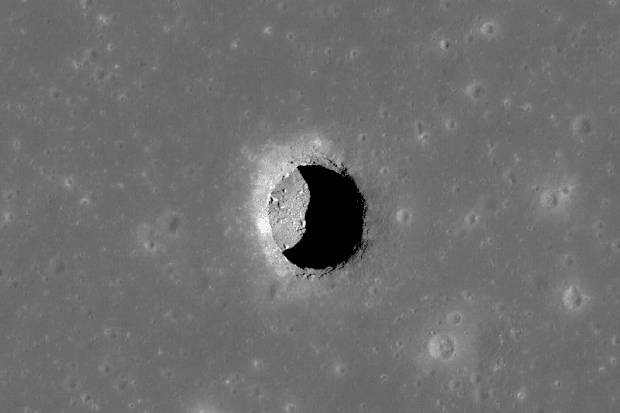It’s Always ‘Sweater Weather’ in These Lunar Pits
A scientific discovery is giving an all-new meaning to The Neighbourhood's hit song.
Have you ever wanted to live on the moon? According to scientists, that out-of-this-world idea may just be possible after all.
A group of UCLA planetary scientists working with NASA first discovered pits on the moon in 2009, but it took them some time to determine what exactly these pits could mean. Now, they say these pits maintain a cool and comfortable 63 degrees Fahrenheit year-round—ideal sweater weather.
Given the moon's oscillating surface temperature, which can heat up to 260 degrees during the day and drop to 280 degrees below zero at night, this is excellent news for those of you that have been dreaming of the day lunar colonies become a reality.

Scientists determined the ideal fall temperature's permanence in the pits by focusing on one specific cylindrical depression—about the size of a football field—located in an area of the moon known as the Mare Tranquillitatis. Using computer-generated thermal models, they found that the temperature in the shaded region of the pit doesn't really deviate.
Scientists believe that some of these pits may lead to lunar caves, which make a promising location for future bases for moon exploration and on-site research. Images taken by NASA's Lunar Reconnaissance Orbiter Camera show visible overhangs on some of the pits that are thought to lead to some sort of cave or void, likely formed from lava tubes.
According to scientists, lava tubes form when molten lava flows beneath a field of cooled lava or a crust forms over a river of lava, leaving behind a long, hollow tunnel. If the ceiling of a lava tube collapses, it opens a pit that can lead into the rest of the cave-like tube. These types of cavities have also been found on Earth.
"About 16 of the more than 200 pits the team of researchers have uncovered are probably collapsed lava tubes," said UCLA planetary science doctoral student Tyler Horvath in a press release.
The research team, which also included UCLA professors of planetary science David Paige and Paul Hayne of the University of Colorado Boulder, hypothesizes that it's the shady overhangs, suspected to be caused by collapsed lava tubes, that are responsible for the temperature-controlled climate which may be conducive to life as we know it.
While the existence of these caves seems to be confirmed in images processed by the Lunar Reconnaissance, more research is needed to know for sure if they're a viable option for life on the moon. Up next is to send a rover to the Mare Tranquillitatis pit to research the layers of lava flows seen in its walls and to explore any existing caves.
According to the release, "Building bases in the shadowed parts of these pits allows scientists to focus on other challenges, like growing food, providing oxygen for astronauts, gathering resources for experiments and expanding the base. The pits or caves would also offer some protection from cosmic rays, solar radiation and micrometeorites."
While neither the research team nor NASA have any current plans to establish an exploration base camp, they've clearly explored the logistics of it. After all, as Paige said, "Humans evolved living in caves, and to caves we might return when we live on the moon.”
The team's complete research can be found in the scientific journal Geophysical Research Letters.
More News: